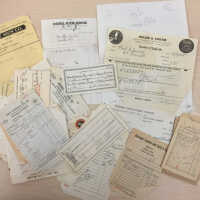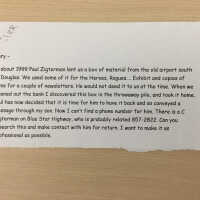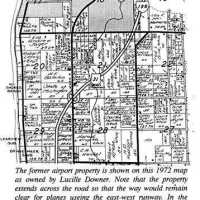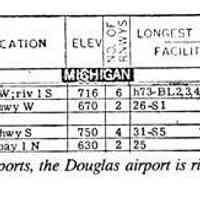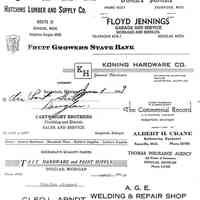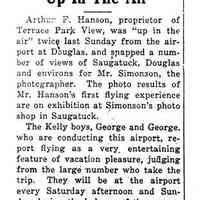Airport documents, Saugatuck Air Park
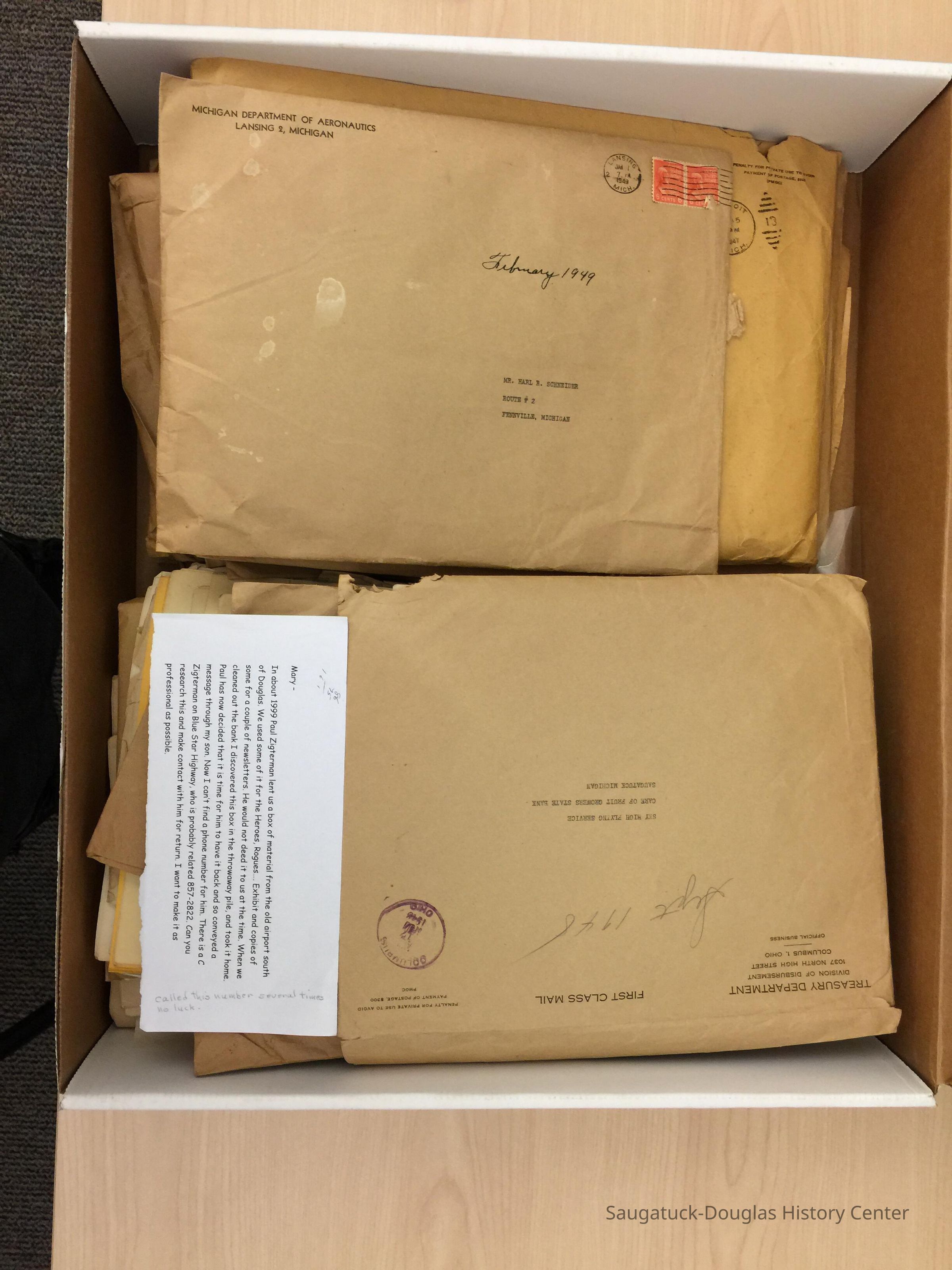
2022.03.19
Buildings: Lost
Winthers, Sally
2022.03
Mary - In about 1999 Paul Zigterman lent us a box of material from the old airport south of Douglas. We used some of it for the Heroes, Rogues.... Exhibit and copies of some for a couple of newsletters. He would not deed it to us at the time. When we cleaned out the bank I discovered this box in the throwaway pile, and took it home. Paul has now decided that it is time for him to have it back and so conveyed a message through my son. Now I can't find a phone number for him. There is a C Zigterman on Blue Star Highway, who is probably related 857-2822. Can you research this and make contact with him for return. I want to make it as professional as possible. Penciled note says "called this number several times no luck."
151 Airpark Airport and Speedway
Cloverleaf Stadium/Airpark Speedway/AirPark AirportSchneider, Harl H. ?-?
https://sdhistoricalsociety.org/publications/NLHist/NLHist/P65-67.php In June of 1946 an airport opened for business just south of Douglas, although it was usually called the Saugatuck-Douglas Airport. It was owned by Harl and Lucille Schneider and advertised "student instruction and scenic tours." In addition, a small restaurant, known as "The Airport Grill," served light lunches. It had two 2500 foot packed dirt runways. In July local pilots joined together to paint the roof of a building in each town with the name of the village and directions and distance to the airport. In Saugatuck the roof of the Jones garage carried the information, in Douglas the lumber yard roof was used. SKY HIGH FLYING SERVICE SAUGATUCK-DOUGLAS AIRPORT Harl Schneider was one of the earliest licensed pilots in the United States. One of his students, who had seen Schneider's pilot's license, said that the number on it was less than 100 and it was issued in 1920 or 1921, just after the end of World War II. Schneider had taught flying at an airport near Holland until he and Lucille were married and opened the Douglas facility. She was also a pilot. They bought the old John Flagg farm just south of Douglas and Albert Crane of Fennville graded the runways. He still has an Indian arrowhead from that excavation. Because of the hardpan clay formations there was some difficulty in getting the runways to drain properly. Crane solved the drainage problem by drilling a five or six foot hole in the problem areas and setting off a stick of dynamite to loosen up the hardpan, then smoothing it over. The east-west runway was built first, followed by the north-south. Later hangars were constructed along the north edge of the first runway. The airport was officially known as the Saugatuck-Douglas airport, but some bills made out to the facility use the name Douglas Lakeside Airport. Mail was received from the Fennville post office, leading to some confusion. Flying instruction was carried on by Harl and Lucille Schneider under the name of "Sky High Flying Service" according to a letterhead. They had two or three Aeronca airplanes, two seaters with one used by the instructor and another by the student, all painted bright yellow. In addition, in April of 1948 the Schneiders purchased a four-place Stinson for their own use and to give scenic rides. The plane was brought to Douglas from Pine Bluff, Arkansas, one of the longest flights recorded in the airport logs. More common destinations were Manistee, Mackinaw City, Kalamazoo, and other small airports in Michigan and Indiana. Records show that planes frequently flew to Muskegon for repairs and maintenance. During World War II many men flew planes who had never even ridden in one before, and many others were exposed to the miracle of flight. The post-war GI bill allowed many of the returning servicemen to attend college and would also pay for the flying course that resulted in a private pilot's license in the interest of "Vocational Rehabilitation." Pilots who had earned their wings flying military planes were another source of income as they adapted their skills to civilian life or simply revisited the thrill of flying without the combat responsibilities. Payment directly from the federal government for veterans taking private pilot training was one of the major sources of income for the airport. One balance sheet shows that in 1948 the operation actually made a profit of over $1,500. In a 1950 Airman's Guide the Douglas-Saugatuck Airport followed the Willow Run airport which serviced Detroit. The listing shows that the Douglas-Saugatuck Airport at Douglas was a commercial facility, it was 1.8 miles south of the center of Douglas, and 670 feet above sea level. There were two runways, the longest 2600 feet, and storage facilities but no repair shop on the premises. Fuel of at least 80 octane was sold there. The cryptic statements under remarks were notes to pilots flying into the facility for the first time. Albert Crane said he remembers the first day the fuel tank was filled. He had dug the hole, the tank was installed and covered. That evening the West Michigan Oil Company truck had put some gas in it, but did not have sufficient in the truck to completely top it off. That night the first really big rain of the season struck the area and the water-soaked ground began to swell. The tank came up out of the ground, with the pump on top. Lloyd Dornan, one of the former students, sometimes gave rides to tourists and was at the airport one day when radio broadcaster Paul Harvey flew in. He asked that his plane be refueled, "Full, and I mean right to the top." Dornan did the best he could and when he was finished Harvey stuck his finger in the top of the fuel tank to make sure it was truly full. When students under the GI Bill had finished their flying courses, there were not enough local people seeking lessons to make ends meet. The airport stayed open for several more years, at least as late as 1951, but was used only by a few local people who owned their own planes and an occasional transient. Harl and Lucille Schneider separated and Lucille married Chester Downer, also a pilot, but who also had an interest in auto racing. About 1952 they called Crane and asked him to build an auto racing track near the back of the property, essentially behind the airport runways. In addition to the quarter-mile dirt track Crane built bleacher seating on banks of earth. The wooden planks that customers sat on were held in place with stakes. It was considered safer than conventional bleachers because customers could not fall through. It was called the Airpark Speedway and featured weekly races in stock and modified open competition classes. Source: SDHS newsletter insert pgs. 65-67
11/20/2021
04/29/2024


